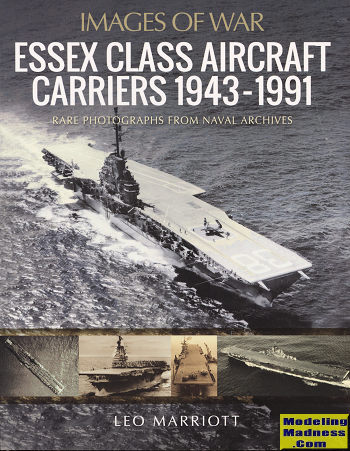 This
addition to the Images of War series concentrates on the Essex class aircraft
carrier. Thanks to America's ability to crank out these sorts of ships during
WWII, the war in the Pacific was able to be carried back to the Japanese much
sooner than without them. They were the largest carriers produced during the war
and entered service in 1943, just when they were needed the most.
This
addition to the Images of War series concentrates on the Essex class aircraft
carrier. Thanks to America's ability to crank out these sorts of ships during
WWII, the war in the Pacific was able to be carried back to the Japanese much
sooner than without them. They were the largest carriers produced during the war
and entered service in 1943, just when they were needed the most.
Able to hold a sizeable air wing they were the primary
method that the Navy had of power projection against the large number of
Japanese held islands in the Central Pacific. A total of 26 of these ships were
laid down. Seventeen were commissioned before the end of the war, seven
completed after than and two were scrapped without being completely built. The
USS Oriskany was not completed until 1950. After the war, many were put into
reserve, with some being called back into service for the war in Korea.
Most of the ships underwent major conversions. One of
them, the '27 Charlie' conversion added the mirror landing system and steam
catapults that enabled them to successfully handle jet aircraft, which needed
more 'grunt' to catapult off the deck. Pretty much all the 27C ships got an
angled deck a bit later in their lives, further extending the usefulness of the
ships into the Vietnam War. By the time of that conflict, the Essex class were
unable to handle the newest jet fighter, the F-4, but were still capable of
operating A-4 and F-8 aircraft. Others were dedicated anti-submarine warfare
ships. It is also interesting that all the Apollo recovery ships were Essex
class.
Eventually they were decomissioned and sold off as
scrap. One, the USS Lexington became a training carrier until it was realized
that a specialized training ship wasn't needed. Four ships survive as museums;
USS Hornet, USS Lexington, USS Intrepid and USS Yorktown.
The book covers the development of the aircraft carrier
then the design of the Essex class. It also provides its use during the middle
and the end of the war along with its operations in Korea. The type was a staple
of the early Cold War and continued to be useful during Vietnam. It was after
than conflict that the last were pulled from active service. Typical of the
series, this one is mostly images. Nicely chosen and while many will seem
familiar to some, there are others that were new to these septuagenarian eyes.
A great addition to the series and one that can be
easily recommended.
January 2021
Copyright ModelingMadness.com. All rights reserved.
Review book courtesy of
Casemate Publishing, where you can order your copy
at this link.
If you would like your product reviewed fairly and
fairly quickly, please
contact
me or see other details in the
Note to
Contributors.
 This
addition to the Images of War series concentrates on the Essex class aircraft
carrier. Thanks to America's ability to crank out these sorts of ships during
WWII, the war in the Pacific was able to be carried back to the Japanese much
sooner than without them. They were the largest carriers produced during the war
and entered service in 1943, just when they were needed the most.
This
addition to the Images of War series concentrates on the Essex class aircraft
carrier. Thanks to America's ability to crank out these sorts of ships during
WWII, the war in the Pacific was able to be carried back to the Japanese much
sooner than without them. They were the largest carriers produced during the war
and entered service in 1943, just when they were needed the most.